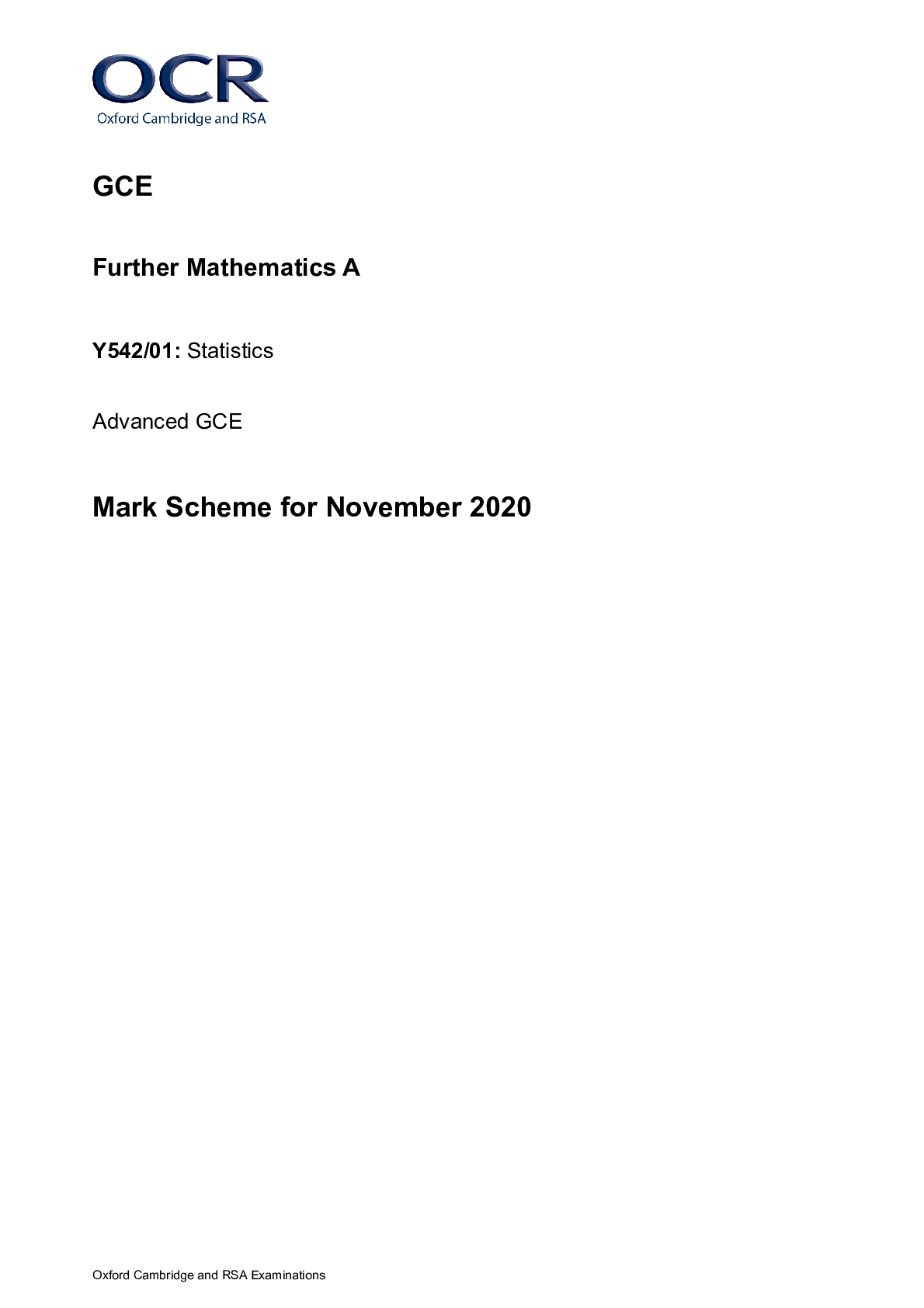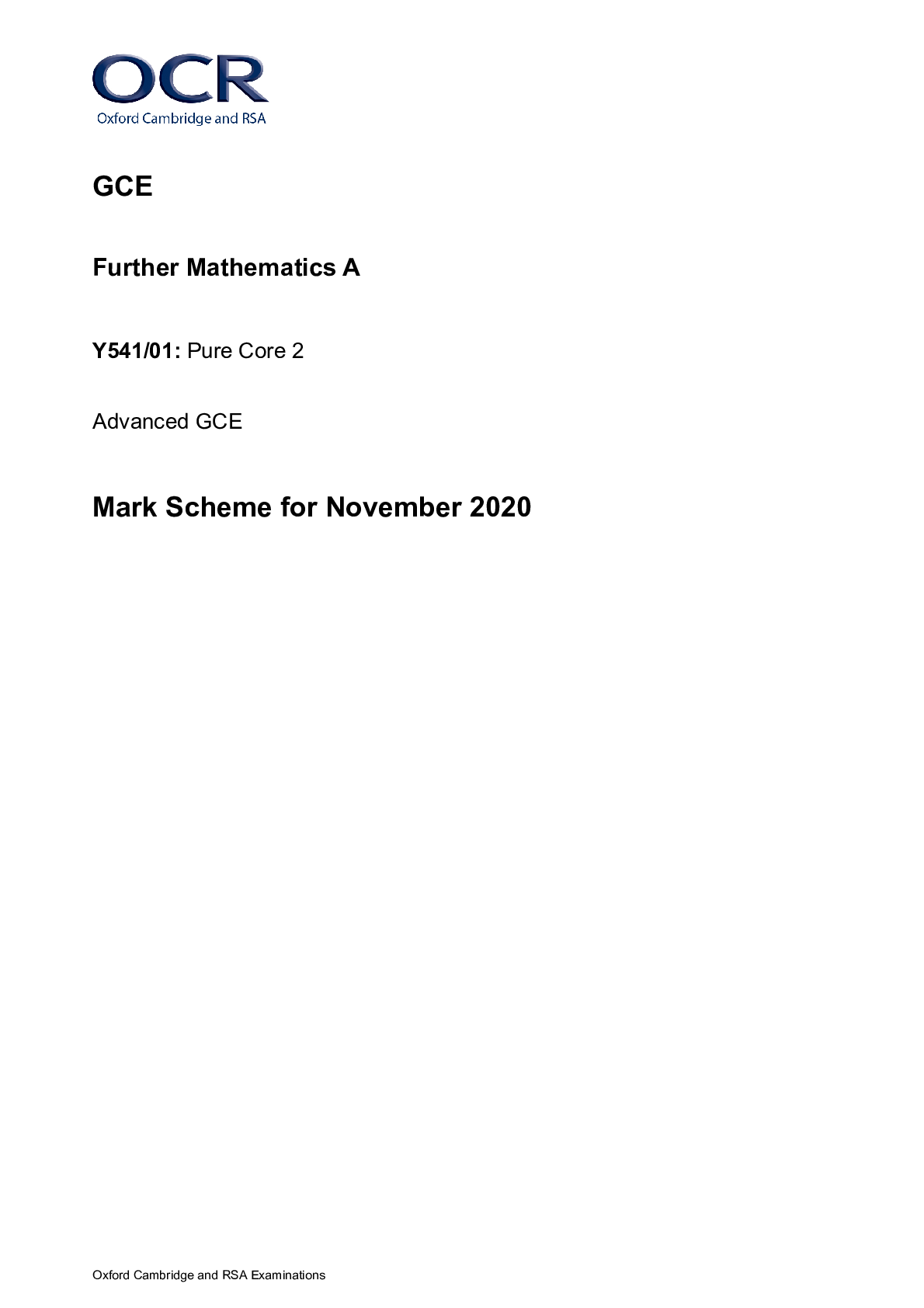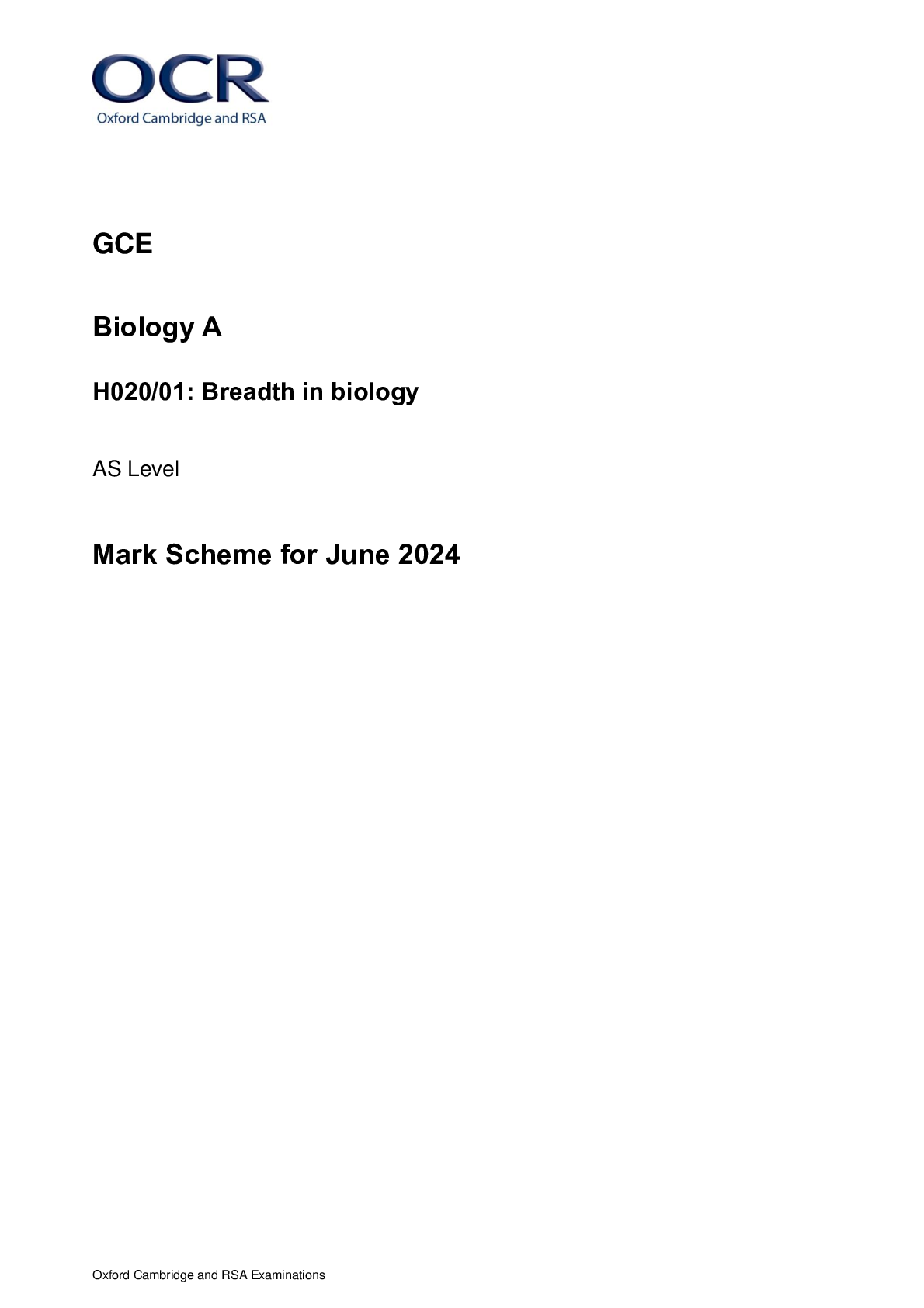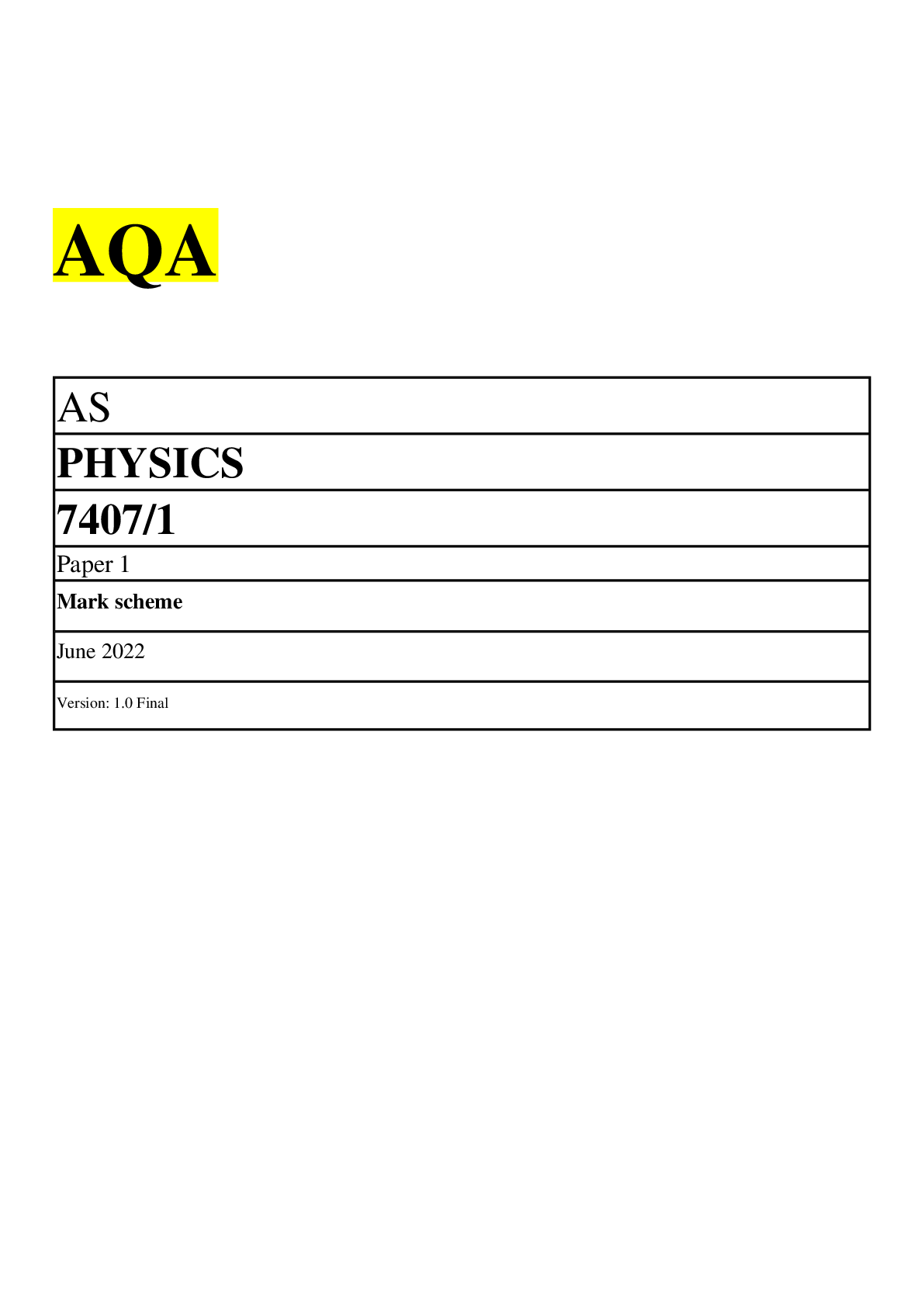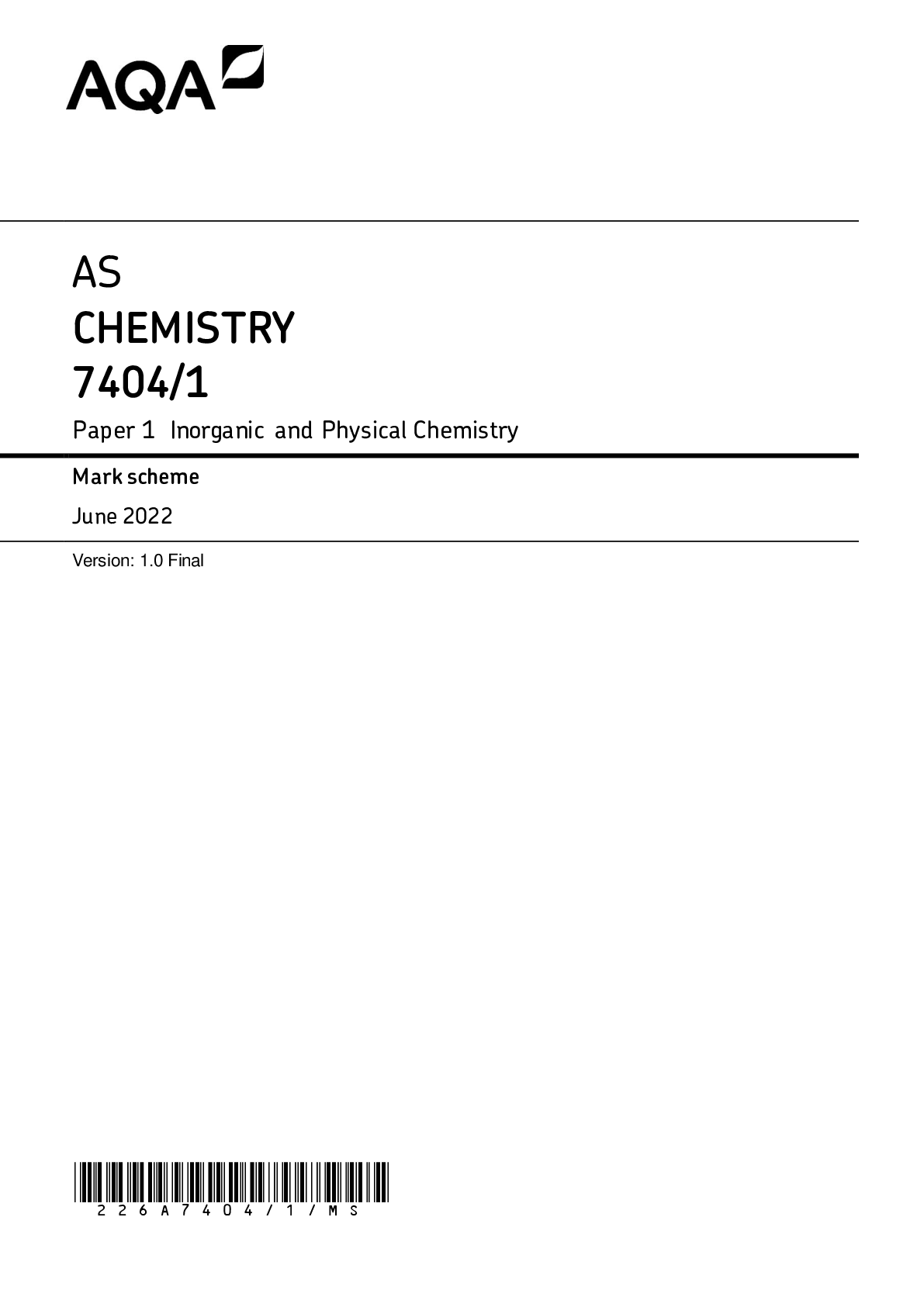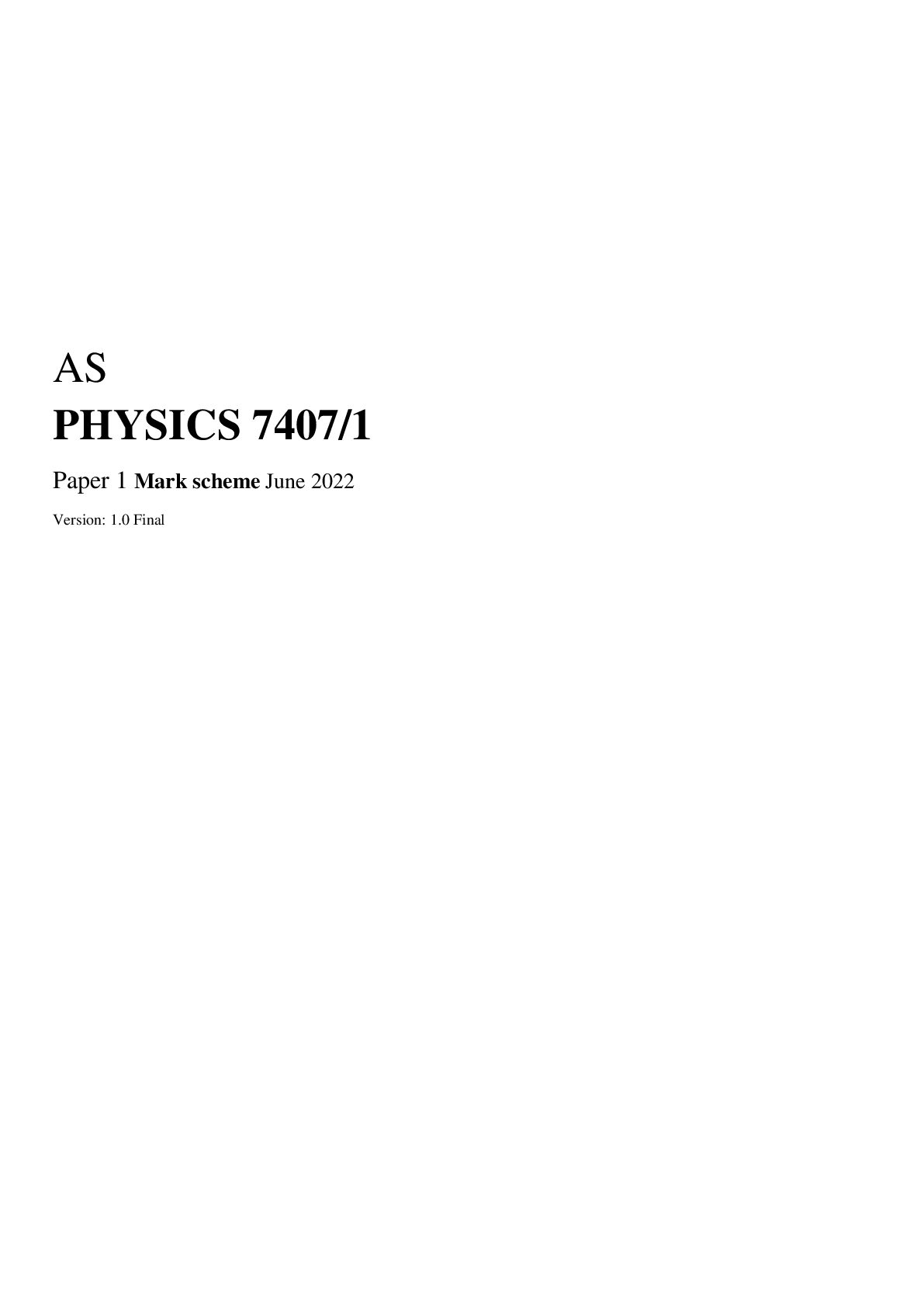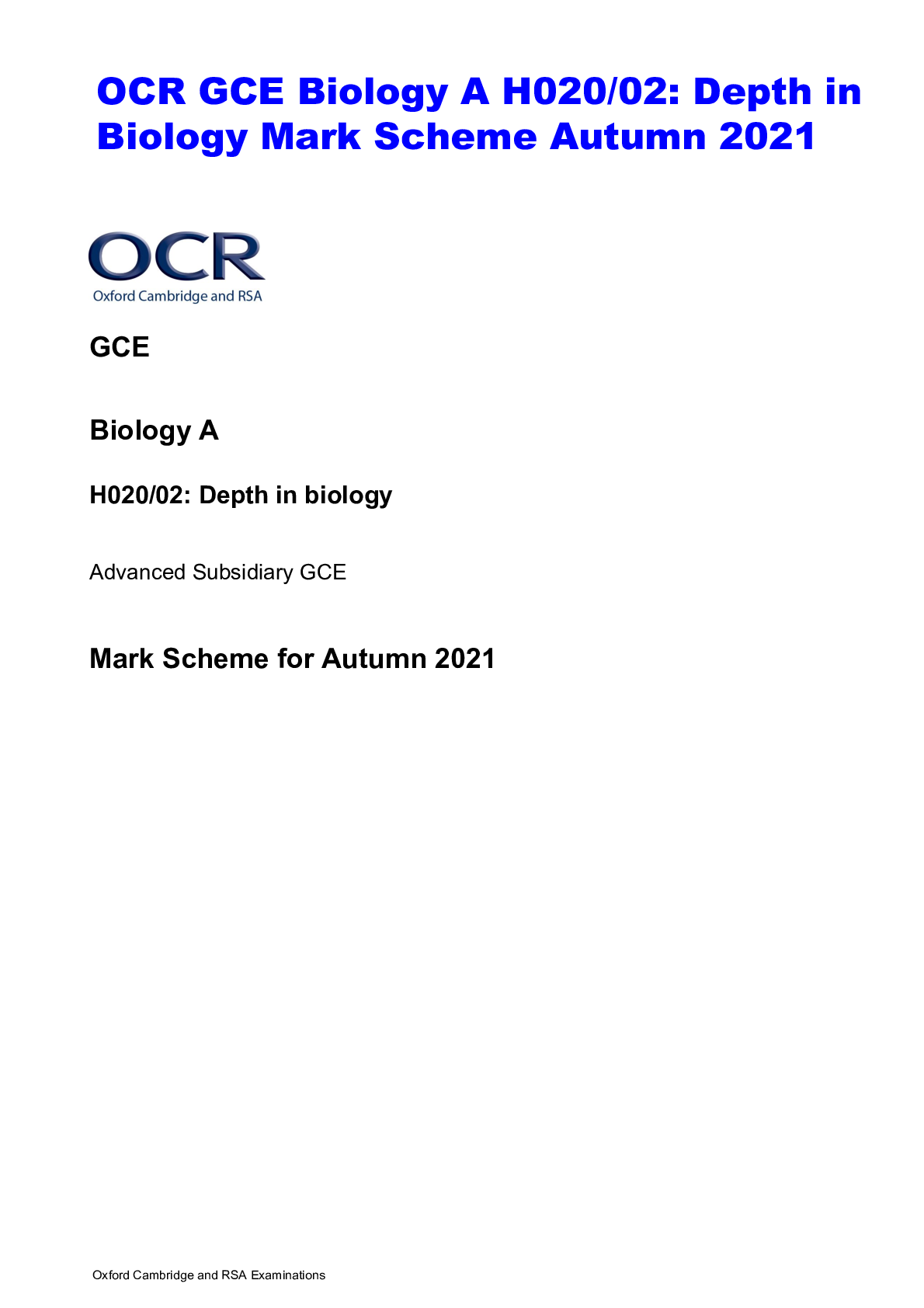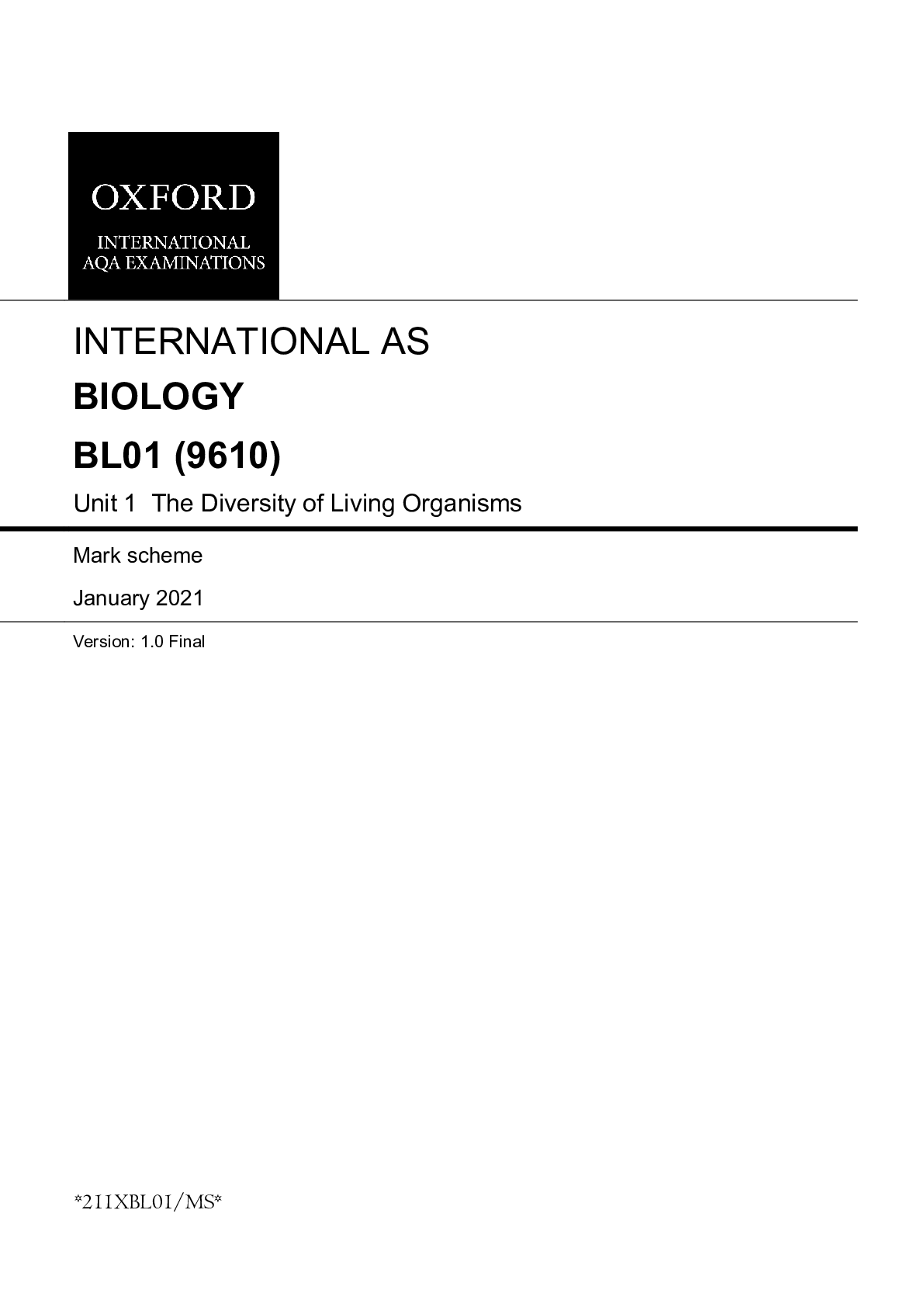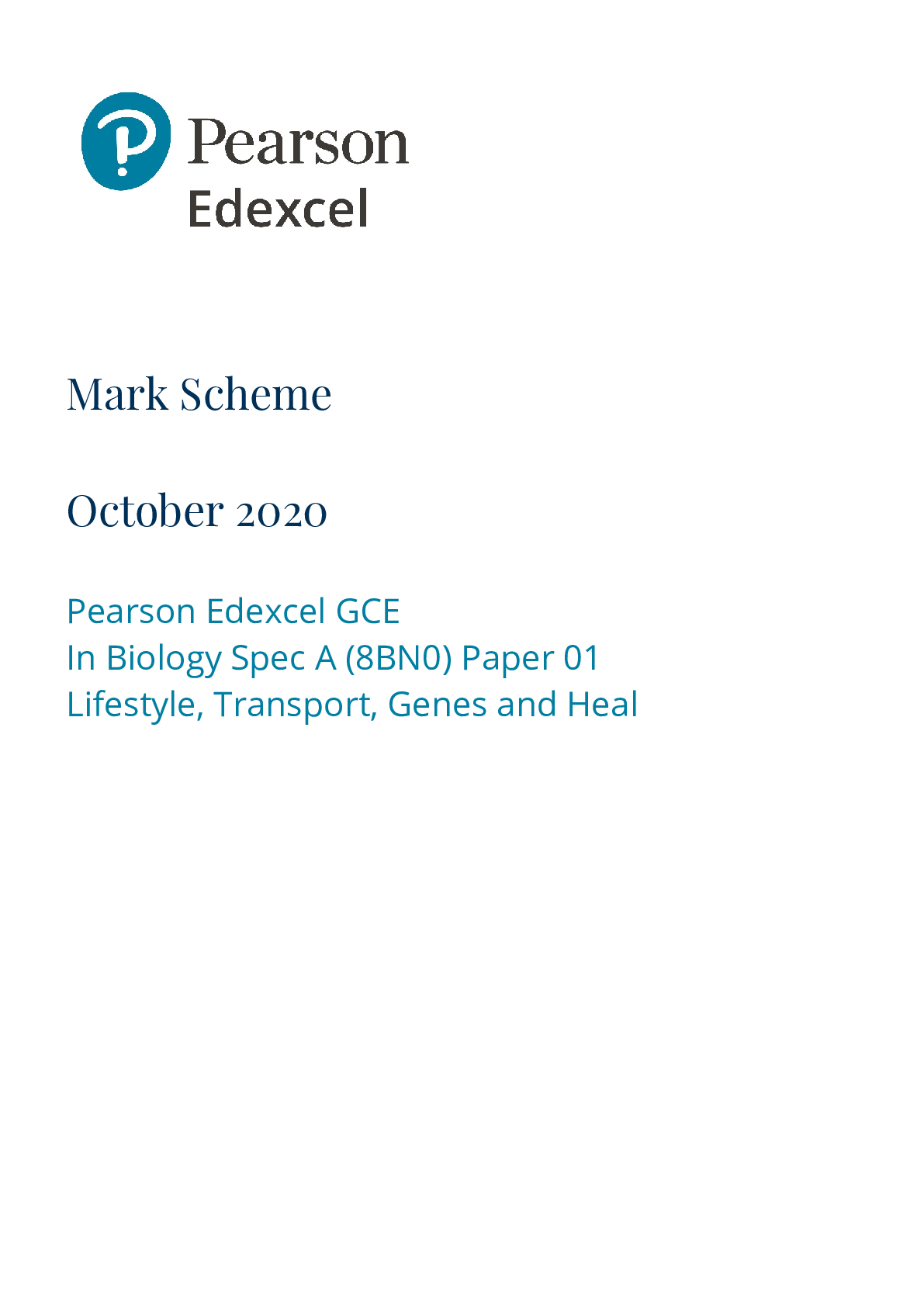Mathematics > AS Mark Scheme > GCE Further Mathematics B (MEI) Y412/01: Statistics A Advanced Subsidiary GCE Mark Scheme for Novemb (All)
GCE Further Mathematics B (MEI) Y412/01: Statistics A Advanced Subsidiary GCE Mark Scheme for November 2020
Document Content and Description Below
Oxford Cambridge and RSA Examinations GCE Further Mathematics B (MEI) Y412/01: Statistics A Advanced Subsidiary GCE Mark Scheme for November 2020Oxford Cambridge and RSA Examinations OCR (Oxford ... Cambridge and RSA) is a leading UK awarding body, providing a wide range of qualifications to meet the needs of candidates of all ages and abilities. OCR qualifications include AS/A Levels, Diplomas, GCSEs, Cambridge Nationals, Cambridge Technicals, Functional Skills, Key Skills, Entry Level qualifications, NVQs and vocational qualifications in areas such as IT, business, languages, teaching/training, administration and secretarial skills. It is also responsible for developing new specifications to meet national requirements and the needs of students and teachers. OCR is a not-for-profit organisation; any surplus made is invested back into the establishment to help towards the development of qualifications and support, which keep pace with the changing needs of today’s society. This mark scheme is published as an aid to teachers and students, to indicate the requirements of the examination. It shows the basis on which marks were awarded by examiners. It does not indicate the details of the discussions which took place at an examiners’ meeting before marking commenced. All examiners are instructed that alternative correct answers and unexpected approaches in candidates’ scripts must be given marks that fairly reflect the relevant knowledge and skills demonstrated. Mark schemes should be read in conjunction with the published question papers and the report on the examination. © OCR 2020Y412/01 Mark Scheme November 2020 2 Text Instructions Annotations and abbreviations Annotation in scoris Meaning and BOD Benefit of doubt FT Follow through ISW Ignore subsequent working M0, M1 Method mark awarded 0, 1 A0, A1 Accuracy mark awarded 0, 1 B0, B1 Independent mark awarded 0, 1 E Explanation mark 1 SC Special case ^ Omission sign MR Misread BP Blank page Highlighting Other abbreviations in mark scheme Meaning E1 Mark for explaining a result or establishing a given result dep* Mark dependent on a previous mark, indicated by *. The * may be omitted if only previous M mark. cao Correct answer only oe Or equivalent rot Rounded or truncated soi Seen or implied www Without wrong working AG Answer given awrt Anything which rounds to BC By Calculator DR This indicates that the instruction In this question you must show detailed reasoning appears in the question.Y412/01 Mark Scheme November 2020 3 Subject-specific Marking Instructions for AS Level Mathematics B (MEI) a Annotations must be used during your marking. For a response awarded zero (or full) marks a single appropriate annotation (cross, tick, M0 or ^) is sufficient, but not required. For responses that are not awarded either 0 or full marks, you must make it clear how you have arrived at the mark you have awarded and all responses must have enough annotation for a reviewer to decide if the mark awarded is correct without having to mark it independently. It is vital that you annotate standardisation scripts fully to show how the marks have been awarded. Award NR (No Response) - if there is nothing written at all in the answer space and no attempt elsewhere in the script - OR if there is a comment which does not in any way relate to the question (e.g. ‘can’t do’, ‘don’t know’) - OR if there is a mark (e.g. a dash, a question mark, a picture) which isn’t an attempt at the question. Note: Award 0 marks only for an attempt that earns no credit (including copying out the question). If a candidate uses the answer space for one question to answer another, for example using the space for 8(b) to answer 8(a), then give benefit of doubt unless it is ambiguous for which part it is intended. b An element of professional judgement is required in the marking of any written paper. Remember that the mark scheme is designed to assist in marking incorrect solutions. Correct solutions leading to correct answers are awarded full marks but work must not always be judged on the answer alone, and answers that are given in the question, especially, must be validly obtained; key steps in the working must always be looked at and anything unfamiliar must be investigated thoroughly. Correct but unfamiliar or unexpected methods are often signalled by a correct result following an apparently incorrect method. Such work must be carefully assessed. When a candidate adopts a method which does not correspond to the mark scheme, escalate the question to your Team Leader who will decide on a course of action with the Principal Examiner. If you are in any doubt whatsoever you should contact your Team Leader.Y412/01 Mark Scheme November 2020 4 c The following types of marks are available. M A suitable method has been selected and applied in a manner which shows that the method is essentially understood. Method marks are not usually lost for numerical errors, algebraic slips or errors in units. However, it is not usually sufficient for a candidate just to indicate an intention of using some method or just to quote a formula; the formula or idea must be applied to the specific problem in hand, e.g. by substituting the relevant quantities into the formula. In some cases the nature of the errors allowed for the award of an M mark may be specified. A method mark may usually be implied by a correct answer unless the question includes the DR statement, the command words “Determine” or “Show that”, or some other indication that the method must be given explicitly. A Accuracy mark, awarded for a correct answer or intermediate step correctly obtained. Accuracy marks cannot be given unless the associated Method mark is earned (or implied). Therefore M0 A1 cannot ever be awarded. B Mark for a correct result or statement independent of Method marks. E A given result is to be established or a result has to be explained. This usually requires more working or explanation than the establishment of an unknown result. Unless otherwise indicated, marks once gained cannot subsequently be lost, e.g. wrong working following a correct form of answer is ignored. Sometimes this is reinforced in the mark scheme by the abbreviation isw. However, this would not apply to a case where a candidate passes through the correct answer as part of a wrong argument. d When a part of a question has two or more ‘method’ steps, the M marks are in principle independent unless the scheme specifically says otherwise; and similarly where there are several B marks allocated. (The notation ‘dep*’ is used to indicate that a particular mark is dependent on an earlier, asterisked, mark in the scheme.) Of course, in practice it may happen that when a candidate has once gone wrong in a part of a question, the work from there on is worthless so that no more marks can sensibly be given. On the other hand, when two or more steps are successfully run together by the candidate, the earlier marks are implied and full credit must be given. e The abbreviation FT implies that the A or B mark indicated is allowed for work correctly following on from previously incorrect results. Otherwise, A and B marks are given for correct work only – differences in notation are of course permitted. A (accuracy) marks are not given for answers obtained from incorrect working. When A or B marks are awarded for work at an intermediate stage of a solution, there may be various alternatives that are equally acceptable. In such cases, what is acceptable will be detailed in the mark scheme. If this is not the case, please escalate the question to your Team Leader who will decide on a course of action with the Principal Examiner. Sometimes the answer to one part of a question is used in a later part of the same question. In this case, A marks will often be ‘follow through’. In such cases you must ensure that you refer back to the answer of the previous part question even if this is not shown within the image zone. You may find it easier to mark follow through questions candidate-by-candidate rather than question-by-question.Y412/01 Mark Scheme November 2020 5 f Unless units are specifically requested, there is no penalty for wrong or missing units as long as the answer is numerically correct and expressed either in SI or in the units of the question. (e.g. lengths will be assumed to be in metres unless in a particular question all the lengths are in km, when this would be assumed to be the unspecified unit.) We are usually quite flexible about the accuracy to which the final answer is expressed; over-specification is usually only penalised where the scheme explicitly says so. • When a value is given in the paper only accept an answer correct to at least as many significant figures as the given value. • When a value is not given in the paper accept any answer that agrees with the correct value to 2 s.f. unless a different level of accuracy has been asked for in the question, or the mark scheme specifies an acceptable range. NB for Specification A the rubric specifies 3 s.f. as standard, so this statement reads “3 s.f” Follow through should be used so that only one mark in any question is lost for each distinct accuracy error. Candidates using a value of 9.80, 9.81 or 10 for g should usually be penalised for any final accuracy marks which do not agree to the value found with 9.8 which is given in the rubric. g Rules for replaced work and multiple attempts: • If one attempt is clearly indicated as the one to mark, or only one is left uncrossed out, then mark that attempt and ignore the others. • If more than one attempt is left not crossed out, then mark the last attempt unless it only repeats part of the first attempt or is substantially less complete. • if a candidate crosses out all of their attempts, the assessor should attempt to mark the crossed out answer(s) as above and award marks appropriately. h For a genuine misreading (of numbers or symbols) which is such that the object and the difficulty of the question remain unaltered, mark according to the scheme but following through from the candidate’s data. A penalty is then applied; 1 mark is generally appropriate, though this may differ for some units. This is achieved by withholding one A or B mark in the question. Marks designated as cao may be awarded as long as there are no other errors. If a candidate corrects the misread in a later part, do not continue to follow through. E marks are lost unless, by chance, the given results are established by equivalent working. Note that a miscopy of the candidate’s own working is not a misread but an accuracy error. i If a calculator is used, some answers may be obtained with little or no working visible. Allow full marks for correct answers provided that there is nothing in the wording of the question specifying that analytical methods are required such as the bold “In this question you must show detailed reasoning”, or the command words “Show” and “Determine. Where an answer is wrong but there is some evidence of method, allow appropriate method marks. Wrong answers with no supporting method score zero. If in doubt, consult your Team Leader. j If in any case the scheme operates with considerable unfairness consult your Team Leader.Y412/01 Mark Scheme November 2020 6 Question Answer Marks AOs Guidance 1 (a) DR E(X) = 0×0.30 + 1×0.38 + 2×0.19 + 3×0.08 + 4×0.05 =1.2 E(X2) = 0×0.30 + 1×0.38 + 4×0.19 + 9×0.08 + 16×0.05 = 2.66 Var(X) = 2.66 – 1.22 = 1.22 M1 A1 M1 M1 A1 [5] 1.1a 1.1 1.1 1.2 1.1 SC if no working shown SC1 for E(X) = 1.2 SC2 for Var(X) = 1.22 1 (b) Because the variance is close to the mean. E1 [1] 2.2b For recognising that the values in part (a) are close. 1 (c) P(X = 2) = 0.2169 P(X > 3) = 1 – 0.9662 = 0.0338 B1 M1 A1 [3] 1.1 3.4 1.1 BC BC 1 (d) P(0) ≤ 0.01 so e−λ ≤ 0.01 λ ≥ 4.6052 So k = (4.6052/1.2) × 10 = 38.4 minutes M1 M1 A1 [3] 3.1b 1.1 1.1 BC If trial and improvement method used award A1 for P(X = 0) = 0.0104 with k = 38 or for P(X = 0) = 0.00928 with k =39 A1 for ‘so k = 39’ OR: e 0.01 −0.12k ≤ 0.12k ≥ 4.6052 So k = 38.4 minutesY412/01 Mark Scheme November 2020 7 Question Answer Marks AOs Guidance 2 (a) Shape of scatter diagram is approx elliptical so evidence to suggest (underlying) bivariate Normality required for test using pmcc to be valid E1 E1 [2] 3.5a 2.4 2 (b) DR S xy = ∑ �� − 1 � ∑ � ∑ � = 25626800 – 1 12 ×18030×15550 = 2262925 S xx = ∑ �2 − 1 � (∑ �)2 = 31458700 – 1 12 × 180302 = 4368625 S yy = ∑ �2 − 1 � (∑�)2 = 21980500 – 1 12 × 155502 = 1830292 r = � �� ������� = 2262925 4368625 1830292 × = 0.800 M1 A1 M1 A1 [4] 1.1a 1.1 1.1 1.1 For attempt to find Sxx , Sxy or Syy For any of Sxx , Sxy or Syy correct For general form including √ Allow 0.80 www 2 (c) H0: ρ = 0 H1: ρ ≠ 0 (two-tailed test) where ρ is the (population) correlation coefficient between x and y For n = 12, 5% critical value (two tailed) = 0.5760 Since 0.800 > 0.5760 the result is significant. There is sufficient evidence to reject H0 There is sufficient evidence at the 5% level to suggest that there is correlation between the concentrations of bacteria and fungi. B1 B1 B1 M1 A1 [5] 3.3 2.5 3.4 1.1 2.2b For both hypotheses For defining ρ in context For critical value For comparison leading to a conclusion e.g. ‘significant’ or ‘reject H0’ For non-assertive conclusion in context. FT their r. Other symbols may be used as long as they are defined as population correlation coefficient No further marks if cv incorrect 2 (d) Because then the probability basis on which the sample has been selected is known. E1 [1] 2.2aY412/01 Mark Scheme November 2020 8 Question Answer Marks AOs Guidance 3 (a) P(Sixth try) = �10 13�5 �13 3 � = 0.0622 M1 A1 [2] 3.3 1.1 3 (b) P(at least once in first six) = 1 − �10 13�6 = 0.7928 M1 A1 [2] 1.1a 1.1 3 (c) P(second time sixth try) = 5 × �10 13�4�13 3 �2 = 0.0932 M1 A1 [2] 3.1b 1.1 Allow M1 if 5 omitted 3 (d) P(at least 2) = 1 – 0.5801 = 0.4199 M1 A1 [2] 3.1b 1.1 M1 for 1 – P(X = 0 or 1) using B(6, 3/13) BC 4 (a) Uniform On the values {1, 2, …, 8} B1 B1 [2] 3.3 1.2 For uniform For values 4 (b) P(X < 4) = 0.375 B1 [1] 1.1 4 (c) E(X) = 4.5 Var(X) = 64−1 12 = 21 4 B1 B1 [2] 1.1 1.1 4 (d) E(Y) = 50 Var(Y) = 102 × 21 4 = 525 B1 M1 A1 [3] 1.1 1.1a 1.1 FT their Var(X) from (c)Y412/01 Mark Scheme November 2020 9 Question Answer Marks AOs Guidance 5 (a) x = 150, y = 9.17 x = 250, y = 6.89 B1 B1 [2] 1.1 1.1 5 (b) The estimate for 150 is likely to be more reliable since this involves interpolation (whereas the estimate for 250 involves extrapolation) E1 [1] 3.5b 5 (c) Because r2 = 0.7303 and because the points lie fairly close to a straight line the fit is fairly good. E1 E1 [2] 2.2a 2.4 For comment relating to r2 or r For comment relating to points 5 (d) It would be since the variables are random on random E1 [1] 2.4 Allow an answer that suggests that the calcium level may depend on the hormone level so it might not be appropriate 5 (e) a = 449.8, b = -32.06 So regression equation is x =-32.06y + 449.8 B1 B1 [2] 1.1 1.1 For either value (3sf or better) Allow B0B1 if only given to 2sf.Y412/01 Mark Scheme November 2020 10 Question Answer Marks AOs Guidance 6 (a) E10: 44×128 250 = 22.5280 E15: (21−22.5280)2 22.5280 = 0.1036 B1 M1 A1 [3] 1.1a 1.1 1.1 FT their E10 6 (b) H0: No association between helmet wearing and distance from curb H1: Some association between helmet wearing and distance from curb Degrees of freedom = 3 Critical value = 6.251 Test statistic = 2.1585 + 0.0601 + ... + 1.8000 = 8.234 8.234 > 6.251 so reject H0 There is sufficient evidence to suggest that there is association between helmet wearing and distance from curb B1 B1 B1 B1 M1 A1 [6] 3.3 3.4 1.1 1.1 2.2b 3.5a No further marks if incorrect cv used M1 for comparison of their ‘8.234’ (using their answer from (a)) with 6.251 leading to a conclusion A1 for non-assertive conclusion in context. FT their ‘8.234’ 6 (c) For distances of 0.3 or below the contributions of 2.1585 and 2.0573 suggest that more do not wear helmets and fewer do than would be expected. For distances greater than 0.8 the contributions of 1.8885 and 1.8000 suggest that more do wear helmets and fewer do not than would be expected. For distances between 0.3 and 0.8 things are as expected if there were no association. . E1 E1 E1 [3] 2.3 3.5a 3.5a SC1 if contributions not mentioned but comments are otherwise correct for both ‘distances of 0.3 and below’ and ‘distances greater than 0.8’.OCR (Oxford Cambridge and RSA Examinations) The Triangle Building Shaftesbury Road Cambridge CB2 8EA [Show More]
Last updated: 3 years ago
Preview 1 out of 12 pages
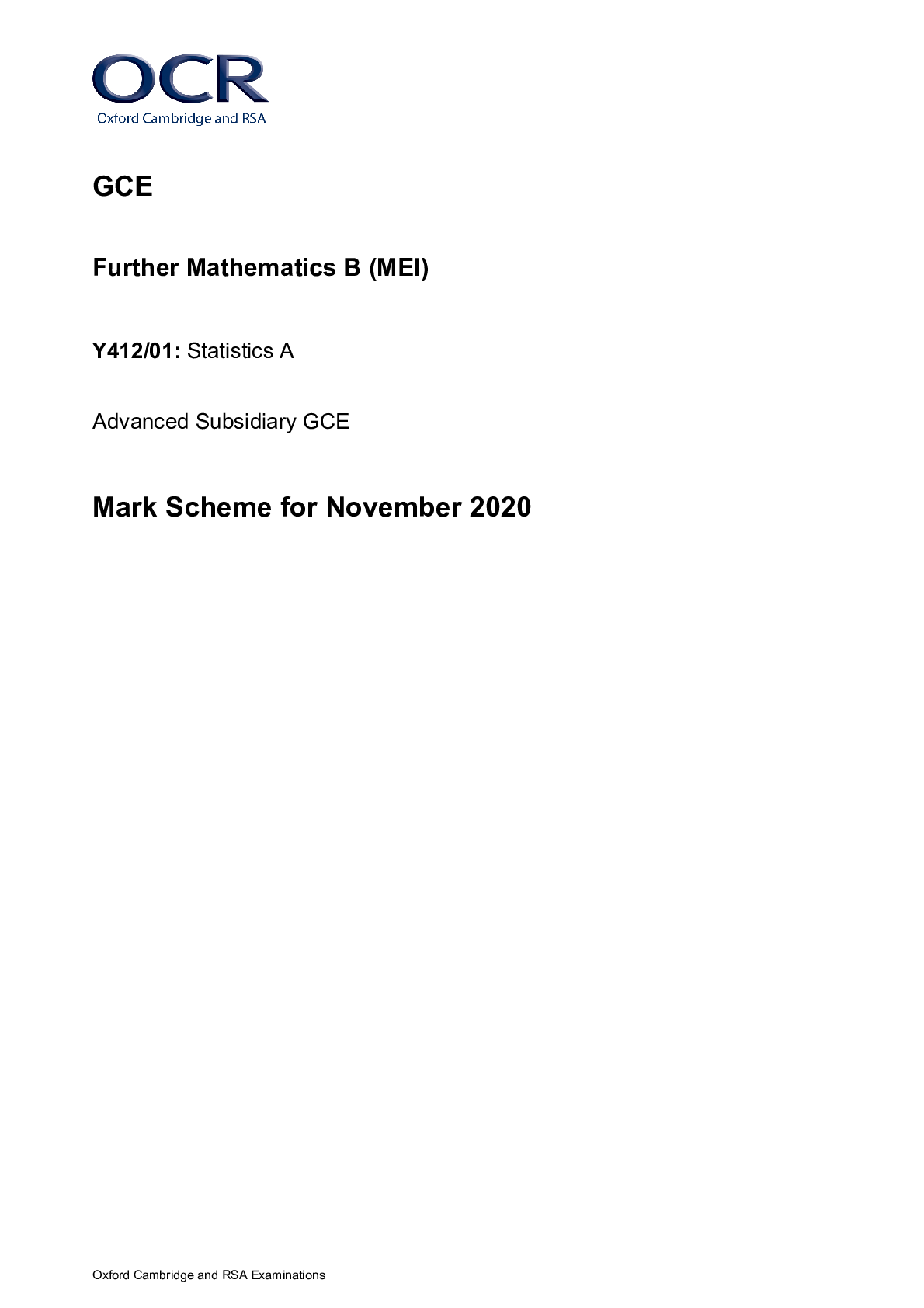
Buy this document to get the full access instantly
Instant Download Access after purchase
Buy NowInstant download
We Accept:

Reviews( 0 )
$6.50
Can't find what you want? Try our AI powered Search
Document information
Connected school, study & course
About the document
Uploaded On
Oct 10, 2022
Number of pages
12
Written in
All
Additional information
This document has been written for:
Uploaded
Oct 10, 2022
Downloads
0
Views
145








